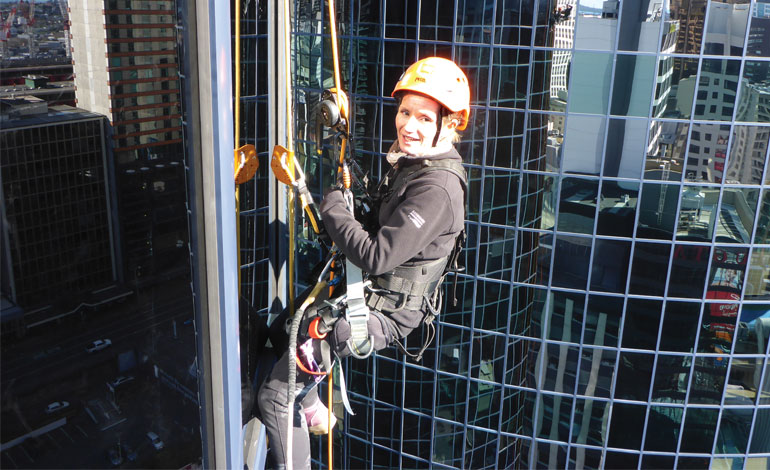Getting stuck up in a Building Maintenance Unit (BMU) on an Auckland high-rise was the catalyst for Victoria Richardson to learn to abseil. ABI KIBBLE explains.
VICTORIA RICHARDSON was stuck in a broken-down Building Maintenance Unit high up in the air with someone from an abseil company and they got talking. By the time the extension ladder had arrived to rescue them to the ground she had made her mind up to learn to abseil.
BMUs are still the main way for surveyors to gain direct access to a structure’s facade, although many surveyors are reluctant to go up in one, and it’s easy to see why, she says.
“They are a bit of a mixed bag. Although the units have six-monthly safety checks, they are usually just left sitting out in the elements unused. More often than not, they are rusty and rickety, which doesn’t fill you with confidence.”
Starting her own business, Copper Seed, earlier this year enabled Victoria to begin making her own decisions.
“It was time for me to put my money where my mouth was – so I signed up with Vertical Horizonz for the National Certificate in Industrial Rope Access Level 3.
“Being able to offer abseiling as a service is a great point of difference for me. Now I’ve completed my Phase 1 training I can work on any high-rise and conduct my inspections close up, which is a huge selling point for my clients.”
The National Certificate combines theoretical knowledge and practical experience. It is achieved through completing a first aid course and fall arrest course, followed by an intensive six-day course covering practical rope skills, rescue techniques and rope access theory.
Victoria is now working towards the required 150 hours for her logbook before she sits her assessment to gain the Industrial Rope Access Association New Zealand (IRAANZ) Certificate of Competence.
In addition to the training at Vertical Horizonz, Victoria has been helped by the team at Extreme Edge Panmure and the climbing centre, which has become like a second home to her.
Safety is paramount and abseiling is subject to stringent rules and regulations.
Abseil teams need to be ‘self-supporting’ at all times and consist of at least two (preferably three) people, so that someone can carry out a rescue if required. Despite appearances, abseiling is extremely safe, thanks to the training, checks and procedures that are in place.
One thing you might be surprised to discover is that Victoria doesn’t have a great head for heights. “I do get scared,” she admits, “but the nerves help to keep me focused. The last thing you want is to become complacent.” She adds, “I’m actually the last person you’d think would be doing this job. Three of us were scaling a building on Queen Street recently, watching the Sky Screamer shooting up and down and shaking our heads. I’m definitely not an adrenaline junkie – you need to be well trained and level-headed for this job.”
 The right work gear
The right work gear
Another essential part of abseiling safety is having the right workwear and personal protective equipment (PPE) and, at just 156cm tall, Victoria often struggles to get the right fit.
“I wear a child’s hi-vis vest aged 11-12 years. It’s the only one I’ve managed to find which is small enough and has a zip-front.
“I used to wear one with a Velcro fastening, but it was forever coming undone and getting caught on things. Hard hats are always an issue, and work boots need to be ordered from overseas.”
Abseil gear is equally problematic.
Victoria needs to wear a bandana underneath her helmet to ensure a snug fit, even when it is fully tightened.
Her harness is the smallest available size, yet still requires some creative work with a karabiner to tighten it up. She also has to set her rig up in a non-standard way to put her in a good position so she can stay safe and comfortable.
“Otherwise it would be like doing ab crunches for two hours,” she laughs.
Victoria gets her abseil gear from DM Standen, which she describes as “absolute legends”.
“When I was getting my first harness they let me try different ones on and hang from a rope they had rigged up so I could get a feel for it.
“Harnesses are complicated and expensive so you need to make sure you get the right one! Being able to try one out in suspension made a big difference for me.
“I would love to see more workwear and PPE for little people but I also understand that there aren’t many pint-size abseiling surveyors out there so you just have to make do sometimes!”
Technology
As well as a vast array of workwear and PPE, technology is an essential piece of kit for an abseil surveyor.
Victoria uses a software package called SkyViewer, developed by SkySurv, which produces models from drone photos and enables her to optimise her abseil route.
“The software has massive safety benefits.
“It helps you to identify the best anchor points and drop areas and to highlight areas of concern which need further investigation.
“Abseiling can be extremely time consuming – 100 metres of building will take me an hour to drop down and survey. Teaming up with SkySurv makes inspection more efficient and ultimately this benefits the client.”
Victoria believes that abseil surveys are becoming the way of the future, mainly because they offer unrivalled access to high areas.
She is rapidly gaining a reputation among her clients for being thorough.
“One of them refers to me as ‘the Grim Reaper’ because I never have good news about the condition of a building – but it’s better to be prepared than wait until things come crashing down!”

